Medals relating to Horses
This page shows medals that relate to mankind's equine friends. Horses have often graced medals, frequently on award medals, but also in transportation, leisure, and mythology. The pegasus shall be included in this category.
Please let me know if I missed a equine-related medal that is already on this site but not part of this collection.
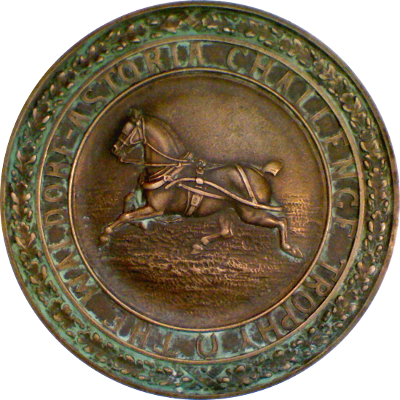
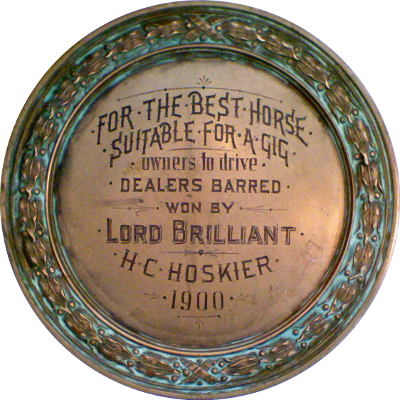
This medal's obverse bears a carriage horse in harness facing left in center field. Around, THE WALDORF-ASTORIA CHALLENGE TROPHY (horseshoe), surrounded by outer border of leaves.
The reverse bears engraved dedication surrounded by leaf border: · FOR · THE · BEST · HORSE · / · SUITABLE · FOR · A · GIG · / · owners to drive · / · DEALERS BARRED · / · WON BY · / · LORD BRILLIANT · / · H · C · HOSKIER · / · 1900 ·
At the turn of the 19th century both horses and clubs were important to one's social standing. It is no surprise that there were a variety of clubs centering on horses that allowed the animals' wealthy owners to compete for honors in various areas. Racing was always popular but in New York City one of the most prestigious trophies to be awarded was the Waldorf-Astoria Challenge Trophy. Around 1900 the annual challenge drew hundreds of competitors who showcased their horses and competed for the $500 award and the honor of owning the best harness horse.
Lord Brilliant was a horse that totally dominated the competitive harness horse scene for the decades between 1900 and 1930 and achieved widespread international fame. He was called "Poetry in motion" and "the finest harness horse to ever step into the tanbark arena." Judges would sometimes just pin the winner's ribbon on him right away before judging the rest of the field. He retired from competition in 1935 in a touching ceremony in which a horseshoe made of hundreds of roses was placed over his neck while one of his stable mates trotted up to him and sketched a deep bow before him. All the while, thousands of spectators cheered and clapped.
This circular medal measures 105mm in diameter and was struck in bronze. It was probably manufactured by Tiffany & Co. but it is not marked such and I have no data in support of this theory beyond the opinion of the person who sold me the medal.
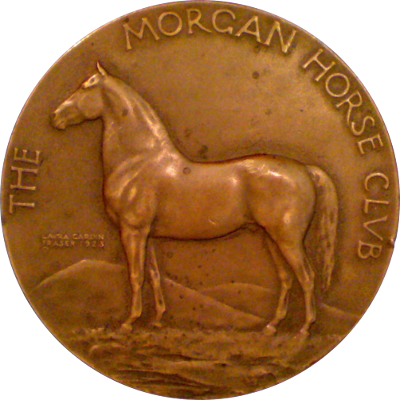
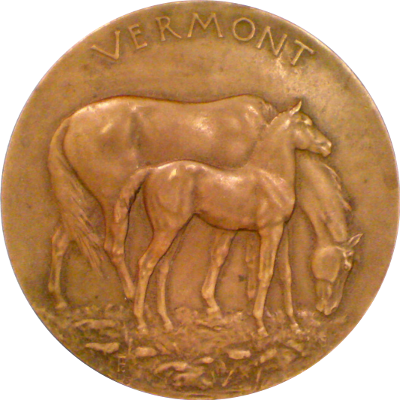
The obverse bears a Morgan horse in profile, facing left. Around, THE MORGAN HORSE CLVB; signed at left next to horse's chest, LAVRA GARDIN / FRASER 1923 / ©
The reverse bears mare with young colt facing right. Above, VERMONT; signed at bottom left, (LGF monogram) / 1923 / ©
The edge is marked MEDALLIC ART CO NY
The Morgan horse is one of the earliest horse breeds developed in the United States. Its foundation sire was named Figure, later Justin Morgan after his best-known owner. Morgans were used as coach horses, harness racing, general riding animals, and as cavalry horses during the Civil War.
This medal measures 75mm in diameter and was struck in bronze by the Medallic Art Company of New York.
References: Baxter 358, Marqusee 173
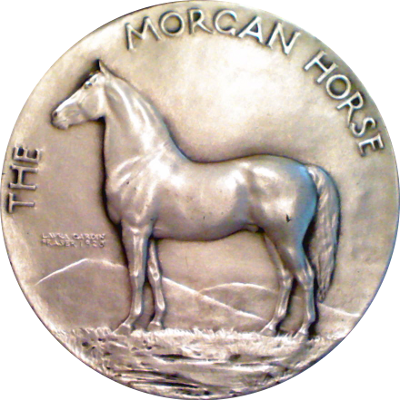
The uniface medal's obverse bears a Morgan horse in profile, facing left. Around, THE MORGAN HORSE; signed at left next to horse's chest, LAVRA GARDIN / FRASER 1923 / ©
The edge is marked MEDALLIC ART CO NY
This is a later variation of the original Morgan Horse Club medal that was used as an award medal by the American Morgan Horse Association (AMHA). I do not know whether Laura Gardin Fraser herself modified the die for the obverse or whether that was done later by someone else. Any additional information about this medal is welcome.


This medal's obverse bears nude male figure restraining rearing winged steed. Signed at right above exergue, (RCW monogram)
The medal's reverse bears facade of Brown & Bigelow building. At top of building, THE HOVSE OF QVALITY / BROWN & BIGELOW; zodiac symbols all around. Signed in exergue, RCWAKEMAN
The edge is marked with MEDALLIC ART CO. N.Y. BRONZE
The Allied Artists of America, Inc., as it is now known, was founded in New York City in the year 1914. The twelve original founders were Ernest Albert, Paul Cornoyer, Marshal Fry, Edmund Greacen, Arthur Powell, Walter C. Hartson, William R. Leigh, Frederick Mulhaupt, G. Glenn Newell, H. Ledyard Towle, H. A. Vincent and Jules Turcas. Its goal is to further the cause of contemporary American artists through its Annual National Open Exhibition in New York City, open to all members and non- members, demonstrations, lectures, awards at the Annual, slide program, a newsletter mentioning all activities of the Members and Associate Members and other cultural activities.
I am not quite sure how Brown & Bigelow came to be commemorated on the medal's reverse, but they likely were a big financial supporter of the organization or possibly underwrote the medal's production. The earliest reference I found to a Brown and Bigelow Award Medal dates to 1929.
The medal measures 63mm in diameter and was struck in bronze and gold by the Medallic Art Company of New York.
References: MACo 1925-042


This medal's obverse bears nude male holding on to a winged horse. Around, N.J. CHAPTER THE AMERICAN ARTISTS PROFESSIONAL LEAGUE -; to right of horse, AWARD / OF / MERIT; signed at lower, left under horse, ECB
The medal's reverse is blank except for inscribed dedication, ROBERT W. DICK / BLACK AND WHITE / 1937
The edge is marked with MEDALLIC ART CO. N.Y. BRONZE
The medal measures 76mm in diameter and was struck in bronze by the Medallic Art Company of New York.




The obverse bears horse head facing left.
Around, U.S. COMBINED TRAINING ASSOCIATION; in center, PRELIMINARY / DIVISION / 1962 for the bronze variant, INTERMEDIATE / DIVISION / 1962 for the silver-plated variant.
The edge is simply marked BRONZE.
The U.S. Combined Training Association (USCTA) was founded in 1959 by Alexander Mackay-Smith, who felt that in addition to the AHSA and USET, a third organization was needed to promote the fledgling sport of combined training in the United States. Combined Training is the triathlon of riding. It combines dressage, cross-country and show-jumping. The USCTA reorganized in 2001 as the U.S. Eventing Association (USEA) to harmonize with international terminology.
I do not know who designed the medal and for how long it was used. Please contact me if you have information abot artist or usage.
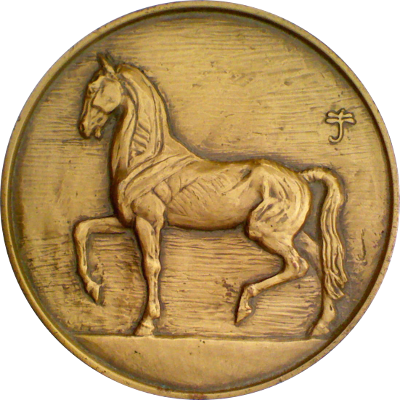
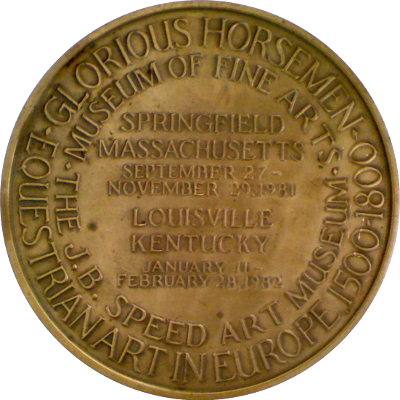
The obverse bears horse in dressage stance. Signed at upper right with dragonfly-reminiscent (J monogram).
The reverse bears only text. In center field, SPRINGFIELD / MASSACHUSETTS / SEPTEMBER 27 - / NOVEMBER 29, 1981 / LOUISVILLE / KENTUCKY / JANUARY 11 - / FEBRUARY 28, 1982; around, · GLORIOUS HORSEMEN · / EQUESTRIAN ART IN EUROPE 1500-1800 / · MUSEUM OF FINE ARTS · / THE J.B.SPEED ART MUSEUM
The edge is marked © 1981 MACO - BRONZE
This medal accompanied a joint exhibition by the Museum of Fine Arts of Springfield, Massachusetts and the J.B. Speed Art Museum of Louisville, Kentucky.
The circular medal measures 73mm in diameter and was struck in bronze by the Medallic Art Company. No mintage was reported. Please contact me if you know the sculptor.